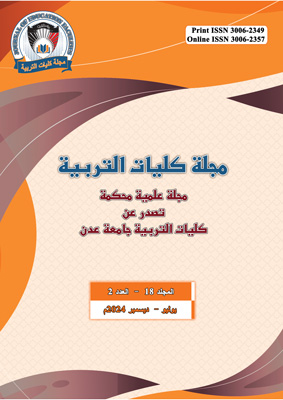The Effectiveness of Using a Robot According to the STEAM Approach on Academic Achievement and Developing Problem-Solving Skills Among Computer Program Students at the College of Education in Aden
DOI:
https://doi.org/10.47372/jef.(2024)18.2.100Keywords:
Effectiveness, Robot, STEAM Approach, Academic achievement, Problem solving skills.Abstract
The study aimed to determine the effectiveness of using robots according to the Steam approach (STEAM) on academic achievement and developing problem-solving skills among students of the computer program at the College of Education in Aden. To achieve the goal of the study, the researcher used the quasi-experimental approach, and the sample of the study consisted of (42) male and female students from The fourth level in the Education Computer Program at the College of Education, Aden, for the academic year 2022-2023 AD, where they were distributed into two groups: an experimental group. And a control group, the experimental group studies using the Arduino robot and electronic parts according to the STEAM approach, and its number is (21) male and female students, and the control group studies in the traditional way, numbering (21) male and female students, and it was confirmed that the students of the study groups are statistically equal in some variables that are believed to affect In the safety of the experiment, they are: the previous academic achievement of fourth-level students in an educational computer program and controlling extraneous variables. The researcher built the study tools, which consisted of an achievement test, which included a set of various objective questions (completion, pairing, multiple choice, true and false), and the test consisted of (30) items and a note card; To measure students’ performance, it consists of (33) performances divided into four axes: The first axis: skills for dealing with the physical components of the Arduino board, and the second axis: Skills for dealing with the software components of the Arduino board (Arduino programming environment), the third axis: Arduino programming skills, and the fourth axis: skills for assembling and designing electronic circuits, and testing problem-solving skills, which included (10) paragraphs, and after ensuring The validity and reliability of the study tools using appropriate statistical methods, the study was applied to the sample and statistical analysis was conducted via the SPSS program, and the following results were reached :
1. There are statistically significant differences at the level of (0.05 ≥ α) between the average achievement scores of the experimental group students and the achievement scores of the control group students in the post-application of the achievement test for the practical side of the artificial intelligence course. For the benefit of the students of the experimental group.
2. There are statistically significant differences at the level of (0.05 ≥ α) between the average scores of problem-solving skills for students in the experimental group and students in the control group in the post-application of problem-solving skills for the practical side of the artificial intelligence course. For the benefit of the students of the experimental group.
Downloads
Published
How to Cite
Issue
Section
License
Copyright (c) 2025 Journal of the Faculties of Education - University of Aden

This work is licensed under a Creative Commons Attribution-NonCommercial 4.0 International License.

